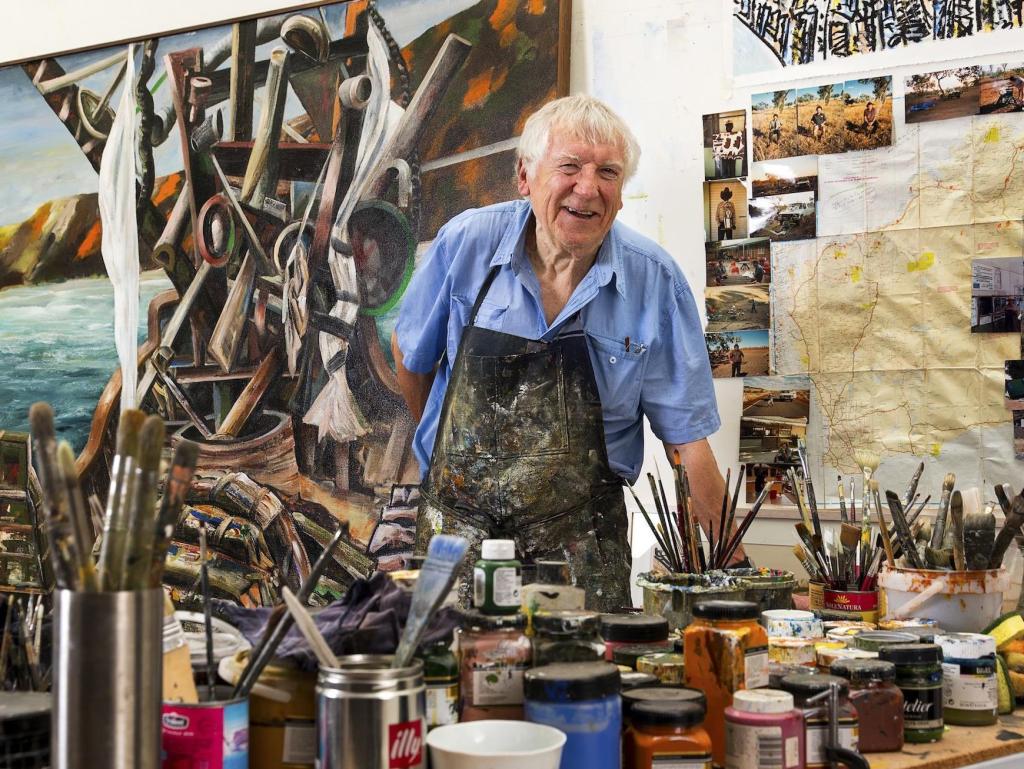Jan Senbergs in his studio; courtesy the artist and NGV, supplied
It feels somewhat surprising that this is the first major survey of the prolific Australian artist Jan Senbergs, now in his mid-70s; the National Gallery of Victoria is to be congratulated on saluting his five-decade career.
Described by the gallery as ‘one of Australia’s most distinctive and individual practitioners,’ the breadth of this exhibition, featuring 120 paintings and works on papers, is testament to Senbergs’ depth of inquiry.
Latvian by birth, he moved to Melbourne in 1950 at 10 years of age, and later described himself as ‘a provincial artist’. He continued in conversation with Australian historian Sasha Grishin: ‘but one who knows the main canons and who does not want to belong in any of them.’
While describing Senbergs as ‘a loner and a maverick’, Grishin also labeled him a ‘gutsy, figurative expressionist and socially committed humanist’.
The picture fits well, and walking around this exhibition, divided across its many rooms, one can only be impressed by the power of Senbergs’ imagery and his unwavering, individual voice, especially in its bold mark-making.
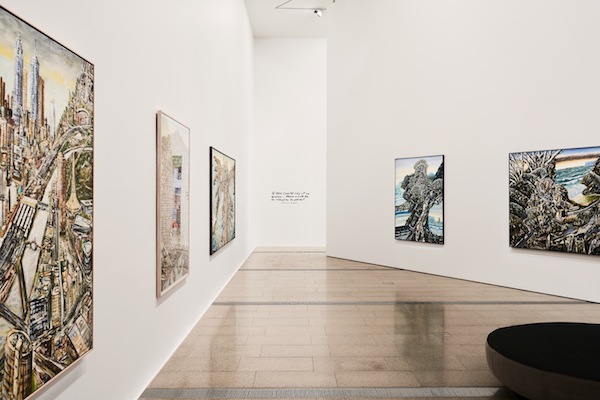
The exhibition’s design helps navigate the viewer through periods and themes; photo by ArtsHub
A singular direction
Entering the exhibition visitors are corralled by a sweeping diagonal wall that seemingly splices time between past and present, locking in polar points of his career.
Logic wants to steer you right, while it is the convention of reading to take the left route, and it’s this path that delivers the viewer to a suite of paintings from the 1960s.
Among them is the standout work, The whipper (1961), as fresh as the day it was painted. Immediately a tone is set for this elegant hang – largely chronological but peppered with museum cases and videographies that build the story.
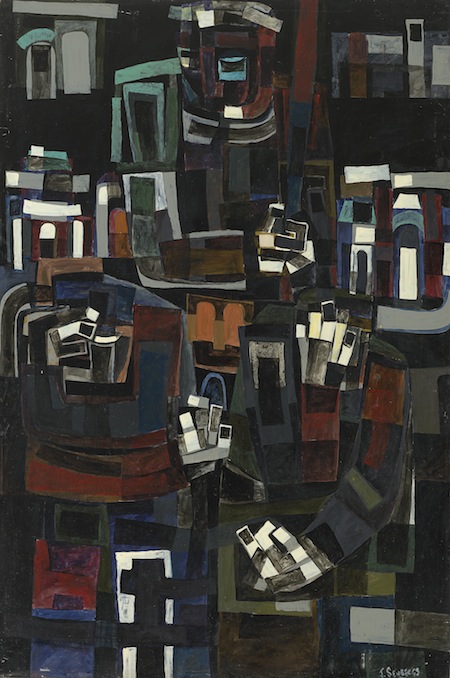
Senbergs’ The whipper (1961); courtesy the artist and Niagara Galleries Melbourne
We see influences, like his training as a commercial screenprinter and his passion for contemporary literature enter the works; Senbergs persistently illustrated his hunger to tap the world around him.
NGV curator Elena Taylor describes him in the catalogue as ‘a scavenger’ and a ‘collector of images taken from anywhere and everywhere’.
She continued: ‘Senbergs’ use of the screenprinting process allowed this repertoire of images to be used and reused in various configurations.’
The exhibition moves the viewer through that coherent evolution of image and influence, at once overwhelming for its sheer volume but superbly curated into digestable chunks. The show comes across as erudite and committed to a singular individual vision.
Milestones as markers
In 1966 Senbergs received the prestigious Helena Rubinstein Travelling Art Scholarship. He returned to Melbourne at the height of The Field exhibition of 1968 at the NGV, and the influential wave of internationalism and a minimal zeal.
Senbergs didn’t fit. But undeterred, what followed was an incredibly productive period in the 1970s as he found his own layered geometric figuration.
He represented Australia at the prestigious 12th São Paolo Biennial in 1973 and was in Canberra on a Fellowship during the dismissal of the Whitlam government. One of his most iconic images, Altered Parliament House I (1976), is a cornerstone of this survey exhibition.
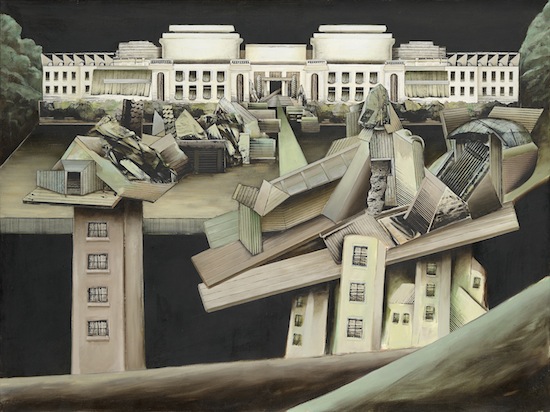
Altered Parliament House 1 (1976), Collection National Gallery of Victoria, courtesy the artist; supplied
It was during this time that an industrial or broken urban landscape motif began to appear in his work – the ships and cranes of his Port Liardet paintings (1980-81) and his Copperopolis – Mt Lyell mining landscape series (1983) offer an aesthetic bridge to the later urban scenes.
The stunning four panel The Port Liardet limner (1992) ‘had a cathartic effect and opened the way to Senbergs’ drawing series of tribal sculptures and studio interiors,’ observed Patrick McCaughey.
These are some of the most exciting works in the show, elegant and definitive as black and white studies, bridging drawing, printmaking and painting, and in many ways offering the point of nexus in Senbergs’s career.
Annex or bridge?
It is not surprising then that this is the point of split, as the exhibition is physically divided in two by the architecture of the building.
While this annexation allowed a moment for pause, the interim landing also served as the site for kind of expo-style presentation of support material, which pulled the standard down.
It did not match the considered, curated museum cases embedded within the exhibition and seemed a cluttered and unnecessary addition (or perhaps artist indulgence).
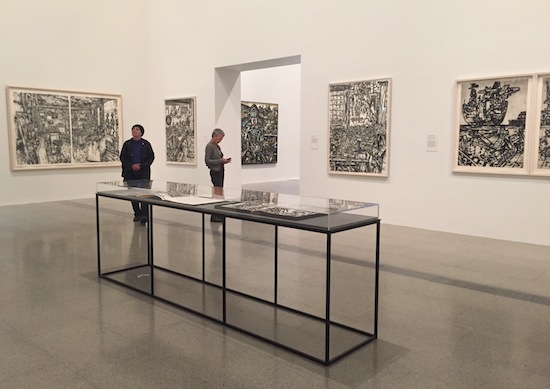
Senbergs’s passion for collecting – his influences stretching wide – were well curated into the exhibition through a series of museum cases; Photo ArtsHub
It is a mere blip, however, in an exhibition that can only be viewed as a superb look at a career, and such moments can be forgiven given our nurtured passion for storytelling today.
This exhibition is huge both in its volume and scale. To assist in its navigation, colour has been used to visually group works within certain periods and thematics. As a device it worked well.
For example, the next chapter of the exhibition starts with works from Senbergs’ Antarctica series (1987), presented against a chilling blue wall. It holds the impact of this vast landscape, the stacked paintings intensifying their impact.

Senbergs’s Antarctica series (1987) sits impressive on a blue wall; photo by ArtsHub
It was paired with a group of paintings from 1990s, Landfall, News, Allegheny Kane walk and the epic 4.6 metre long Pulaski Skyway (1998), which reflected upon the post-industrial landscape of freeway that crosses from Newark to Jersey City, and a post-Gulf War America.
Senbergs had been Visiting Chair in Australian Studies at Harvard University in 1989, and these paintings that followed were both an autobiographical reflection and ‘a metaphor for the American experience and its splendour and decay.’
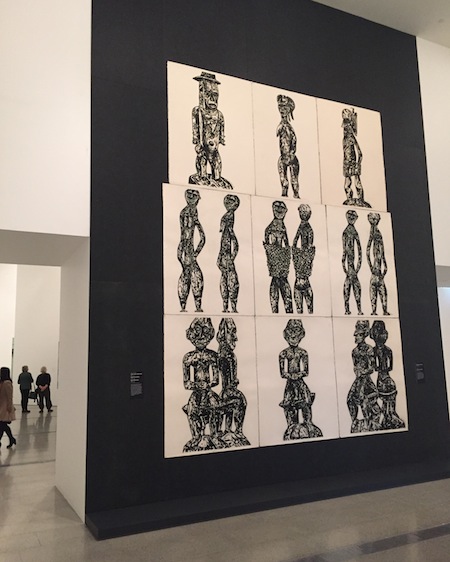
The exhibition then changes again dramatically in tone. A smaller gallery is seemingly stretched vertically as a suite of New Guinea studies (pictured above) and studio and house interiors graphically command the space and demand our attention.
On the flipside of this blackened wall – again playing with the drama of presentation – is a salon hang of paintings from Senbergs’ 2014 Victorian bushfire series, blazing in hue.
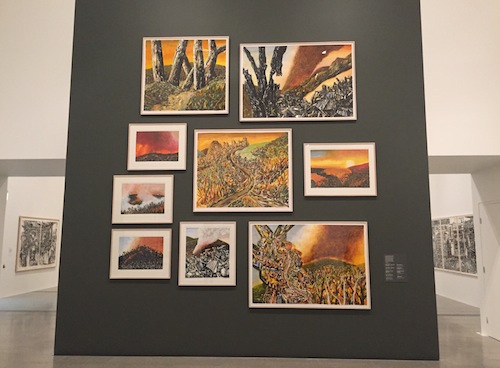
Salon hang of works of Victoria’s bushfires intensifies their impact (2014); photo by ArtsHub
They return us to that entry point (or end point) of the exhibition, a circle that returns upon itself, somewhat appropriately marked by Senbergs’ sprawling aerial views of cities.
These paintings have a playful, labyrinthine quality that read like maps but are foiled by the addition of imagination and memory.
Fittingly, among them are several paintings of Senbergs’ hometown of Melbourne.

Melbourne 1998-99, Collection State Library of Victoria Melbourne, courtesy the artist; supplied
Scale remains the resonant takeaway from this exhibition. Senbergs was far from a shy painter.
There is an incredible confidence in that scale of painting, one that is paired with a sureness of draughtsmanship, and rigorous in subject – political yet poetic at the same time.
While the exhibition borders on being tight in its hang, in moments it feels cohesive and in conversation. That speaks of unmistakable sincerity of making.
Tony Ellwood, Director, NGV, concluded most aptly: ‘As one of Australia’s leading contemporary artists, Jan Senbergs is an extraordinary inventor of his own visual language, at once simple and bold.
‘From lush landscapes to barren urban spaces, his body of work signifies an artist who has continually experimented with shape, form and motif, and one who to this day continues to push his art in new and unexpected directions.’
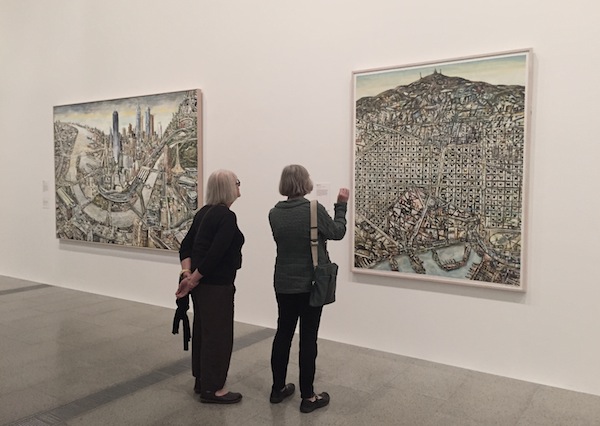
This exhibition is a proud moment for both gallery and artist, and the journey as a viewer is well rewarded.
Rating: 4.5 out of 5
Jan Senbergs: observation – imagination
The Ian Potter Centre: NGV Australia, Melbourne
18 March – June 2016
www.ngv.vic.gov.au
